|
|
|
| During the summer months butterflies of all shapes and sizes can be seen fluttering or gliding across the vegetation. Amongst them are: Long Tailed Blues, Southern White Admirals and the Two Tailed Pasha, which breeds on the Strawberry tree. At night a great variety of moths including the Hawk Moths can be seen, it is a good idea to leave a light on and see what it attracts. For the more curious or gruesome this also serves as a good location to watch Geckos stalk their prey. Amongst those regularly seen are – | |
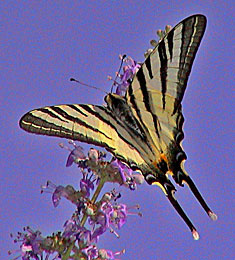 Scarce swallowtail |
Scarce Swallowtail: - (Iphiclides
podalirius) Despite its name is the most common Swallowtail in Europe; it is so called because of its rarity in the British Isles. It’s flight is distinctive in that it appears to glide like a paper aeroplane in reverse. Wingspan is approx. 70mm to 80mm. Can be seen from may to September. Habitat is lowlands including gardens, orchards and scrubland. Caterpillars feed on fruit trees, brambles, hawthorn etc. |
 Comma |
Comma: - This butterfly has unusual torn looking wings, which are mottled brown underneath. In northern Europe it has a white comma shaped symbol underneath its wings, hence its name. But in southern Europe it is represented by the Southern Comma which has smaller wing spots ( see Photo. ) and instead of a comma symbol it bears a white v shaped symbol on the wing undersides. Wingspan is 45 to 50mm. Adults spend the winter in hedgerows making full use of their camouflage to avoid detection. |
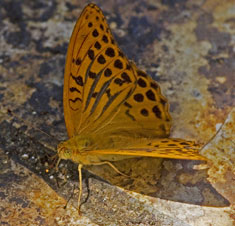 Silver-washed fritillary |
Silver-Washed Fritillary: - (Argynnis
paphia) A large butterfly which prefers a forest like environment. The female does not have the long dark streaks on her wings, which in the male, contain the scent scales. The underside of the hind wing is mottled pale green with silver streaks, hence its name. Wingspan is up to70mm. Frequently found close to deciduous trees and shrubs from June to September, some times in large numbers, especially during flowering time. Eggs are laid on trees and the caterpillars feed on violets and similar plants. |
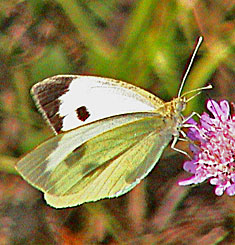 Southern small white |
Southern Small White (Artogeia
mannii): - The male has a single black spot on the top surface of the forewing whereas the female has two black spots. Both male and female have two black spots on the lower surface of the forewing. The hind wings are white above and yellowish below in both sexes. Can be seen flying from March till October. Likes hot rocky terrain and gardens. |
 Gatekeeper |
Gatekeeper or Hedge Brown: - There are usually two distinct white spots on the eye of the forewing although in this specimen the second spot is very faint. The forewing is mainly orange beneath whilst the hindwing is brown and yellow with distinct brown spots with white centres. Very fond of bramble, and likes scrubland. Caterpillars feed on a variety of grasses. Wingspan is approx 40mm. |
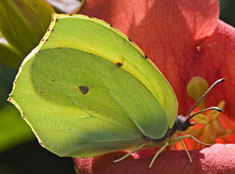 Brimstone |
Brimstone: - Distinguished by the red spot in the centre of all four wings and the forewing, which sweeps out to a point. The male has yellow upper wing surfaces whilst the female has pale green . Wingspan is up to 60mm. Found in open woodland and gardens. They overwinter in evergreen foliage and are amongst the first butterflies to appear in spring. |
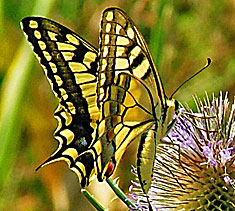 Common swallowtail |
Common Swallowtail: - ( Papilio
machaon ) This is one of the more striking butterflies to be found on Corfu. It loves the flowery meadowlands between the olive groves. Rarely at rest and active from April to October. ( 3 broods ) Wingspan is over 70mm. Caterpillars are creamy white with a random black and red striped pattern. They feed on milk parsley, fennel, carrots etc. The caterpillars also have a aromatic organ which is deployed if under threat, called the osmeterium from the Greek word osme which means scent. |
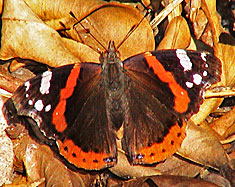 red admiral |
Red Admiral: - (Vanessa atalanta) The upperside colouration is unmistakable. The undersides are similar but paler and less distinct. Adults overwinter to reappear again in spring. Its favourite haunts are flower gardens. Wingspan is up to 60mm. Caterpillars feed on nettles. |
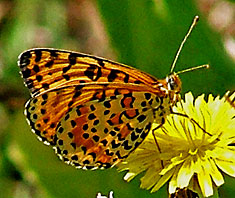 Spotted fritillary |
Spotted Fritillary: - (
Melitaea didyma. ) The upper wing colouration can vary with the male a darker shade of orange. The underside of the wings is usually as in the photograph. Look for the two orange stripes on a cream background. Likes flowery meadows and gardens. Wingspan is 40mm. Approx. Visible from april till September. Caterpillars are cream below and black on top with orange tufts, they overwinter as a group in a silk nest. Caterpillars feed on toadflax, plantains etc. |
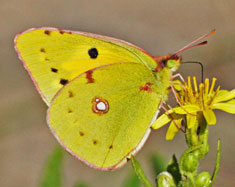 Clouded yellow |
Clouded yellow: - ( Colias
crocea ) This butterfly is fast flying and hardly ever opens it’s wings when at rest. The outer edge of the upper wing surfaces has a wide black border from front to rear. Can be seen from April to October in meadows and flowery scrubland. Wingspan is approx. 50mm. Caterpillars feed on clover, vetch and similar legumes. About 10% of the females have a paler colouration. |
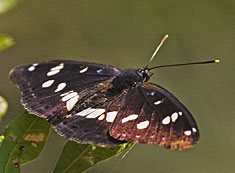 Southern white admiral |
Southern White Admiral: - (
Limenitis reducta. ) The upper wing surfaces are black with a slight violet sheen and white markings. The underside is russet brown with white and grey markings and small black spots at the edges. Can be seen gliding on the perimeter of woodland and shrubs from May till September. Wingspan is 55mm. Caterpillars feed on honeysuckle. |
 Common blue |
Common Blue: - ( Polyommatus
icarus. ) This is a male, the female is brown with blue on the upper wing surface, the upper wing is also bordered with orange spots containing a smaller black spot. To be found on grassy meadows. The wingspan is about 35mm. Can be seen from April to October. Caterpillars feed on birdsfoot trefoil and similar plants. |
 Eastern bath white |
Eastern Bath White: -( Pontia
Edusa ). The Eastern Bath White is visibly indistinguishable from the Bath White. The top surfaces of the wings are white with black Dalmatian like spots on the wingtips. Found throughout the majority of eastern and south eastern Europe. Habitat is rough scrubland at low altitudes. Caterpillars feed on wild crucifers etc. Active from February to October. Wingspan is approx 45mm. |
 Hummingbird hawkmoth |
Hummingbird Hawkmoth: - (
Macroglossum stellatarum ) Active during daylight. Wingspan up to 50mm. Unmistakeable in its hummingbird like behaviour as it visits flowers whilst feeding. Caterpillar is emerald green with longitudinal white and yellow stripes on each side, also a red dot on each body segment between the stripes. Caterpillars feed on bedstraws. Can be found all year round in southern Europe. |
 Tiger moth |
Tiger Moth: - This moth flies by day or night. Black and cream forewing with a beautiful scarlet hind wing, which is strikingly visible when flying. Flight period is from late may till early September. Habitat includes, Riverbanks and other moist environments. Wingspan is approx. 50mm. |
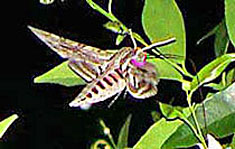 Convolvulus hawkmoth |
Convolvulus Hawkmoth: - ( Agrius convolvuli ) Migrates from Africa every spring to breed in Europe. Can be seen regularly at dusk when it resembles a hummingbird as it feeds with its very long proboscis. This photo is at a mandarin tree. Distinguishable by its greyish head and pink striped abdomen. Caterpillars feed on bindweed and other members of the convolvulus family. Wingspan is approx 100mm.
|
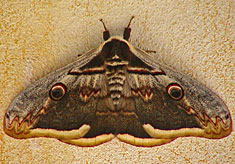 Giant peacock moth |
Giant Peacock Moth: - ( Saturnia Pyri ) This species is the largest moth to be found in Europe. Its wingspan is close to 140mm. Therefore it is understandable why it is often thought to be a bat when flying at night. This photo is the female, the male has feather like antennae. The adult moth does not feed, but the caterpillars which are 10cm. long, feeds on various deciduous trees including fruit trees and is regarded as a nuisance by fruit tree owners. They are bright green with blue protrusions topped with irritant bristles. The moth is active from March to late June. |
| Download PDF version of this website with more photographs etc. in the downloads section. | |










